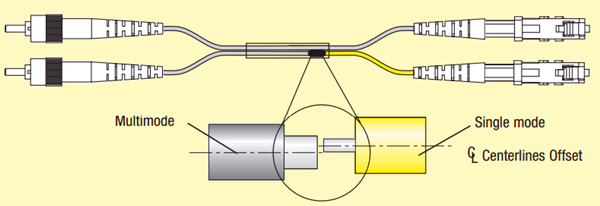Guide to Mode Conditioning Patch Cord
As we all know, 1000BASE-LX transceiver modules can only operate on single-mode fibers. Thus, if we use a Cisco SFP-GE-L 1000BASE-LX/LH SFP module in a multi-mode fiber system, it might pose a problem. When a single-mode signal is launched into a multi-mode fiber, a phenomenon known as differential mode delay (DMD) will appear. This effect can confuse the receiver and produce errors. To solve this problem, a mode conditioning patch cord is needed.
A mode conditioning patch cord is a duplex multi-mode cord that has a small length of single-mode fiber at the start of the transmission length. The basic principle behind the cord is that you launch your laser into the small section of single-mode fiber, then the other end of the single-mode fiber is coupled to multi-mode section of the cable with the core offset from the center of the multi-mode fiber (see diagram below).

This offset point creates a launch that is similar to typical multi-mode LED launches. By using an offset between the single-mode fiber and the multi-mode fiber, mode conditioning patch cords eliminate DMD and the resulting multiple signals allowing use of 1000BASE-LX over existing multi-mode fiber cable systems. Therefore, these mode conditioning patch cords allow customers an upgrade of their hardware technology without the costly upgrade of their fiber plant.
- Mode conditioning patch cords are usually used in pairs. Which means that you will need a mode conditioning patch cord at each end to connect the equipment to the cable plant. So these patch cords are usually ordered in numbers. You may see someone only order one patch cord, then it is usually because they keep it as a spare.
- If your 1000BASE-LX transceiver module is equipped with SC or LC connectors, please be sure to connect the yellow leg (single-mode) of the cable to the transmit side, and the orange leg (multi-mode) to the receive side of the equipment. The swap of transmit and receive can only be done at the cable plant side.
- Mode conditioning patch cords can only convert single-mode to multi-mode. If you want to convert multi-mode to single-mode, then a media converter will be required.
- Besides, the requirement for mode conditioning patch cables is specified only for 1000BASE-LX/LH transceivers transmitting in the 1300nm window. They should never be used in 1000BASE-SX links in the 850nm window.

Mode conditioning patch cords play an important role in telecommunication networks by significantly improving the data signal quality and increasing the transmission distance. Fiberstore offers mode conditioning patch cords in all varieties and combinations of SC, ST, MT-RJ and LC fiber optic connectors. All of Fiberstore's mode conditioning patch cords are at high quality and low price.